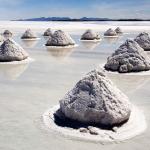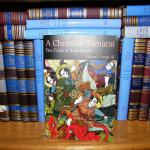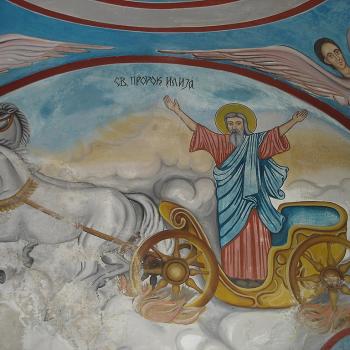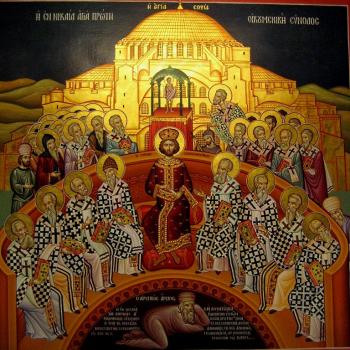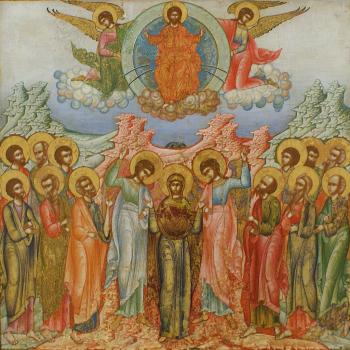In giving birth thou didst preserve thy virginity; in falling asleep thou didst not forsake the world, O Theotokos. Thou wast translated to life, O Mother of Life, and by your prayers you deliver our souls from death (Troparion of the Dormition).
Jesus was born of the virgin Mary. This is how God the Son, the Logos, chose to dwell among us: he truly became man, and this was done in and through Mary. Her body was the source and foundation of his own flesh and blood. What was hinted at in the Genesis myth between the relationship of Adam and Eve is made fact in the relationship between the New Adam and the New Eve. Jesus took on himself flesh from her flesh: it was the sole source of his humanity. He took it, transformed it, and made it his own, so that he could truly become man and be all that it is for a man to be.
Mary, by her very nature, is the connecting link between the God-man and the rest of humanity; through her he became man, truly man. He had the same nature as the rest of us, although unlike the rest of us, he lived in and with it in a perfectly pure and natural way, so he was without sin. He acted according to the purity of his human nature; he acted according to what nature suggested in each and every instance of his life; since the conditions which established his activity were based upon his own personal place and interactions in the world unique to his person, though he acted according to nature, we do not need to think the universal nature which underlies all of us will make us all act the same as he did if we find our way back to our original purity. When we are restored to our pristine natural goodness, our nature will direct us as persons, and as persons we will have relative distinctions which establish our activity, though it will all be within the matrix of perfect humanity and what we will do be done without need for deliberation for what is good in each condition will be perfectly clear and without question. Only through a fallen mode of willing which is sub-natural will evil be taken on and cause us to be confused as to what is good, leading to the need for deliberation as to what is the real and true good.
Mary, therefore, as the source and foundation of his humanity, is herself the specially prepared vessel of Christ’s humanity. She was perfected in and through the work of the Holy Spirit in time so that she could become a perfectly natural human, free from the stain of sin, so that she could render to Jesus a body untainted by the contamination of sin. The process of establishing her, the new Eve, Daughter Zion, is what is demonstrated in the history of Israel, through the line of David. Grace from the eschatological work of Christ, the Lamb of God slain from the foundation of the world, was able to be applied slowly to those who cooperated with the work God established for Israel, until at last, Mary was conceived and the final fulfillment of God’s plan for creation could take effect. Through Mary, Jesus was to become the Messiah, the fulfillment of the prophecies which incorporated the line of David, even as he was to become the source and foundation by which humanity could be returned to its natural purity and lifted up into deifying grace. Mary represented the fullness of natural human perfection which could be handed over to God in the conception of the God-man, Jesus. God the Son, born of the Father before all ages, is born again in time, in and through the assumption of human nature so that he became truly a man. He did not appear to be man, he truly was man; the assumption of humanity unto himself was not some illusion, but the eschatological reality which he established for himself.
Jesus, is the Logos, the Alpha and Omega, the beginning and the end. He is all of this in himself (cf. Rev. 22:13). He is the beginning and the end, the archon and the eschaton, in his eternal unchanging activity as God. When he became man, when he assumed human nature unto himself, he joined the two natures in his one person; they are not confused, but they become uniquely related so that what is said of him in his person is what he does in and through both of his natures. Paradoxes ensue. He who is God fasts, grows hungry, and eats. All that is human, authentically human, he has assumed to himself, though the actions of his humanity are human, remaining human even as his divine activity remains true to itself. But because of who he is, though there is no confusion of natures, the interdependent relationship they form in the hypostatic union establishes various effects for humanity. God has opened up space for humanity, indeed, for the whole of creation, into the divine life. Creation is allowed to partake of the divine nature, to be deified. This is because he who is the eschaton brings eternity itself into creation and time. When the eternal one became man, the eschaton was made immanent in creation. Jesus, the mediator between God and man, brought the eschaton into time, bridging the two, so that those in time can enter into the eschaton and find themselves established in him and rendered unto eternal life. Without that bridge, creation was stuck in and of itself and the gate to heaven, to eternity, was closed; with that bridge, death is no longer the end, and those who die go to Jesus, finding in him the eschaton itself. They can go through him as the door who opens up to eternal life. Those who empty themselves of sin through his grace, those who willingly open themselves up to his love, will find he opens himself up for them and in him, takes them to eternal glory.
What is key is that in and through the incarnation, the whole world is affected; it is not abandoned. Indeed, objectively it has all been raised up. As the one who is in heaven came down to earth, so now those on the earth will not be forsaken. When Jesus ascended back to his Father, he now renders all that has been assumed in him, all the earth and creation, over to the eternal life, so earth can be said to be lifted to the heaven. The eternal one, in assuming eternity, emptied himself so that the earth could be lifted up to heaven:
Have this mind among yourselves, which was in Christ Jesus, who, though he was in the form of God, did not count equality with God a thing to be grasped, but emptied himself, taking the form of a servant, being born in the likeness of men. And being found in human form he humbled himself and became obedient unto death, even death on a cross. Therefore God has highly exalted him and bestowed on him the name which is above every name, that at the name of Jesus every knee should bow, in heaven and on earth and under the earth, and every tongue confess that Jesus Christ is Lord, to the glory of God the Father (Phil. 2:5-11 RSV).
The eternal one emptied himself so that the eschaton can become immanent and deifying grace could enter the world. The eternal one emptied himself, and now human flesh finds the kingdom of God can dwell within. The eternal one emptied himself, and now heaven and earth find themselves united as one in his eternity. The eternal one emptied himself, taking a form of a servant. The eternal one shows us that it is as a servant of love we find true glory. He was exalted even in his flesh; he ascended to show us that all that he is, all that he assumed, is to be glorified and lifted up, to be a part of his eternal life. Through his emptiness, the heavens open wide and receive the fruit of his work.
This is exemplified in Mary. Heaven joined with earth within her womb, making her the seat of wisdom; indeed, though confined in space, she became as it were a throne wider than the heavens (for God transcends even the heavens). In her, the eschaton and time became one. Deifying grace took her flesh and rendered it to be the flesh of the God-man, Jesus. Her flesh is what is taken so that the Logos can become man; her flesh has therefore become tied to the destiny of her Son. When he ascended into heaven, he took flesh from her flesh with him; but so long as she remained on earth, his work was incomplete, only when she was taken completely to heaven did he complete his own ascension, for the ascension included taking up all that was of his flesh which meant all that was her flesh as well. This is why in her assumption Jesus completed the eschatological reorganization of creation and has opened up the path for the whole of humanity to be assumed into heaven: for in her, it is shown that Jesus did not take flesh and disconnect it from the destiny of everyone else, but showed it is intricately connected to the whole of humanity through Mary his mother as the one who connects Jesus to us.
Mary always, followed after her son and was with him in his earthly ministry, not only in her person, but in his flesh. Therefore, she was to follow after him and his deeds, taking on death for herself so that she could then be open to his elevation of her by her assumption into heaven. She followed after her son, always open to and bending herself to follow him, dying to herself, completely and perfectly open to the prompting of God in her life. Death was the natural end of her life, for it was the final fulfillment of her own self-emptying; by it, she completely followed the path her son had established. She died, was placed in a tomb, with the Apostles at her funeral; thus she is said to have gone asleep (dormition), for sleep is the euphemism Scripture uses for those who die in Christ, used to indicate that death is not the end but the transference of the one who dies to eternity. As the resurrection of Christ shows him to be the firstborn of the dead, with her flesh itself glorified, the assumption of Mary is the perfection and completion of the resurrection, rendering her resurrected in eternity. Her unity with Jesus is why the tomb is said to have been unable to hold her back; as she was raised to heaven, to forever be the seat of Wisdom from which Christ reigns, so that now she intercedes for all:
Neither the tomb nor death could hold the Theotokos, who is sleepless in her intercessions and an unchanging hope in her mediations. For as the Mother of Life she was transferred to life by Him Who dwelt in her ever-virgin womb (Kontakion of the Dormation).
Truly she died but death did not reign in her; truly she was assumed into heaven ,but she has not abandoned the earth by it. Heaven and earth have been joined together. Eternity and time have been joined together. The beginning and end are one in the eschaton which has become immanent. The eschaton has become immanent, and the implications are eternal. The eschaton has become immanent, and the earth is raised up to heaven. The eschaton has become immanent and the sin which covered the world has been shaken off, the veil has been taken down, and the reality of the union of the two can now be told.
[Image=Dormition of Mary By Masters of Grudziądz Polyptych via Wikimedia Commons]
Stay in touch! Like A Little Bit of Nothing on Facebook


